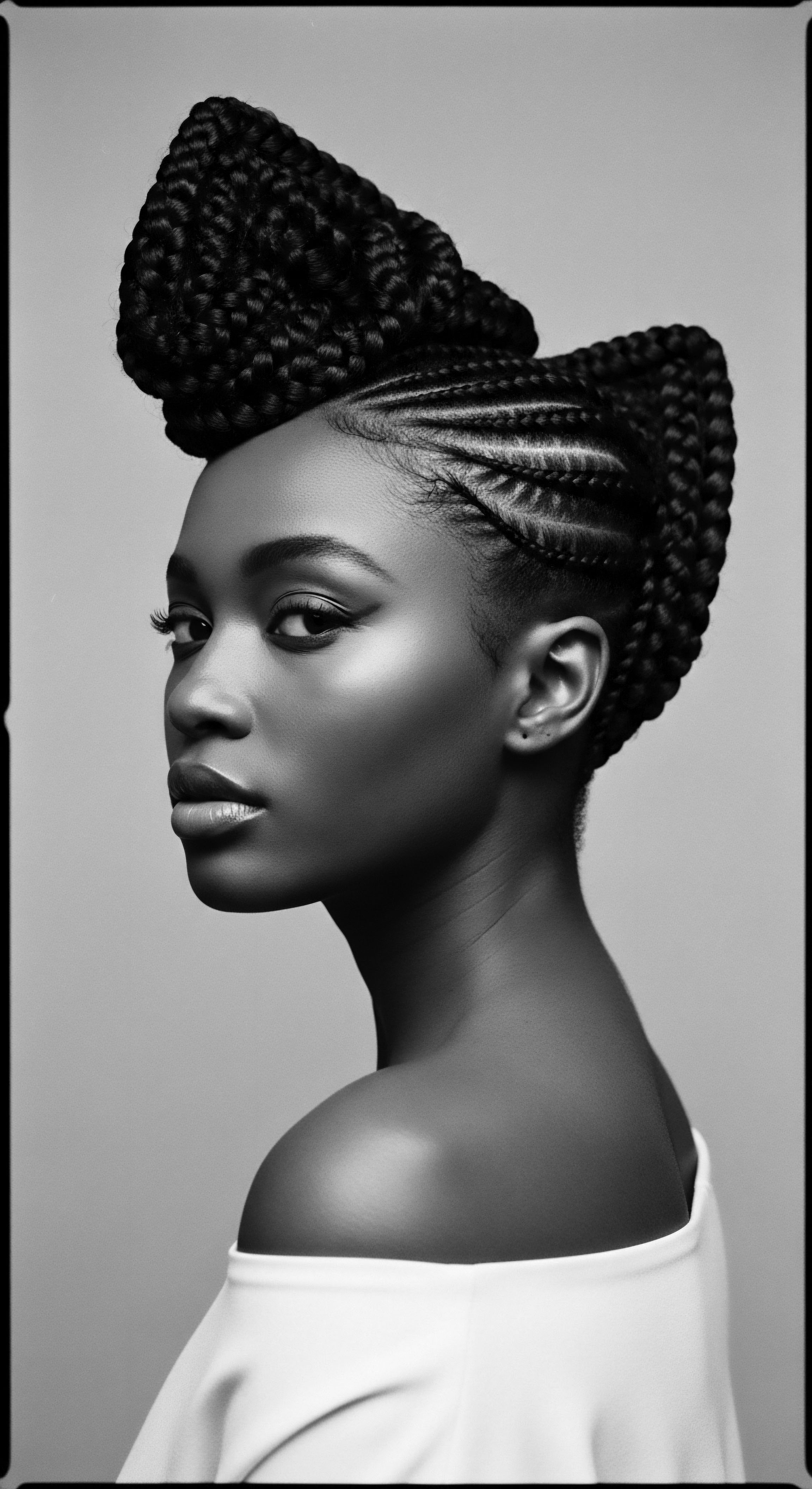
Roots
In the quiet spaces where ancestral wisdom lingers, where the whispers of generations past echo, lies the profound story of textured hair. It is a chronicle written not merely in strands, but in ritual, resilience, and identity. For those whose lineage traces through the intricate coils, kinks, and waves that define textured hair, understanding its heritage is a journey inward, a recognition of an enduring legacy. This exploration invites us to consider how natural elements, particularly henna, served as foundational cornerstones in the care and celebration of such hair throughout history, long before the advent of modern formulations.

The Architecture of Textured Strands
Each textured strand, a testament to genetic artistry, possesses a unique helical structure, influencing its strength, moisture retention, and styling possibilities. Unlike straight hair, which tends to be more cylindrical, textured hair often exhibits an elliptical or even flat cross-section, particularly at the points where it bends or twists. This anatomical distinction impacts how external agents interact with the hair shaft.
Ancestral communities, though lacking microscopic insights, intuitively understood these properties through observation and consistent practice. Their approach to care was a symphony of attentiveness, recognizing the need for gentle handling and nourishing ingredients.
The cuticle, the outermost layer of the hair, is particularly significant for textured hair. Its scales, which lay flatter in straight hair, are often more raised or lifted in textured hair, making it more prone to moisture loss and tangles. This natural predisposition explains why ancestral practices so often prioritized emollients, humectants, and protective measures, striving to seal the cuticle and guard the hair from environmental stressors.
Textured hair, with its unique helical architecture and often raised cuticle, inherently seeks deep moisture and gentle handling, a truth long understood in ancestral care practices.

Henna’s Place in Ancient Hair Science
How did henna, derived from the dried leaves of the Lawsonia inermis plant, ascend to such prominence in ancestral textured hair care? Its power stems from lawsone, a vibrant dye molecule that, when mixed with an acidic medium, binds to the keratin protein in the hair. This binding process coats the hair strand, adding a layer of protection and strength without penetrating the cortex in a way that chemically alters the hair’s internal bonds. For textured hair, which can be more susceptible to breakage due to its structural bends, this external reinforcement offered significant advantages.
In various cultures, from North Africa to the Middle East and parts of Asia, the use of henna was not simply cosmetic. It was a sophisticated application of botany and chemistry, passed down through oral traditions and practical demonstration. The understanding of how henna adhered to the hair, staining it richly while simultaneously fortifying it, was a form of empirical science refined over millennia. This understanding was not codified in laboratories but lived within the skilled hands of communal caregivers, the wisdom keepers of hair tradition.
Consider the Sahara’s edges, where ancient Nubian communities embraced henna. Archaeological discoveries, such as those made at the site of Kerma, attest to early uses of henna for adornment and preservation. For hair, the plant offered not just a beautifying tint, but a noticeable improvement in resilience, especially in harsh, arid climates. The conditioning properties of henna would have helped to mitigate dryness and protect against sun damage, which are significant concerns for hair that naturally struggles with moisture retention.

Traditional Classification Systems and Henna’s Role
While modern hair typing systems (like Andre Walker’s 1A-4C) are relatively recent, ancestral communities often had their own, more fluid, and culturally specific ways of describing and categorizing hair. These classifications were often tied to familial lineage, regional variations, and even spiritual beliefs. Within these frameworks, hair treated with henna might have been recognized for its enhanced sheen, vibrant color, and apparent robustness.
For example, within certain West African traditions, hair texture might be described using terms relating to specific plant fibers or natural phenomena, indicating its density, curl pattern, and responsiveness to moisture. Henna, through its consistent application, contributed to a hair state that was considered healthy and beautiful within these traditional aesthetics. It was part of a holistic lexicon of care, where the visual and tactile qualities of hair were paramount indicators of its wellbeing.

Ritual
The journey with textured hair, in its deepest sense, is a ceremony. Every twist, every comb stroke, every application of a nurturing balm carries the weight of generations, a testament to ingenuity and self-regard. This is particularly true when we consider how elements like henna were not merely products, but central figures in elaborate rituals of care and communal connection. Its application was an art form, a science of transformation, and a conduit for shared cultural understanding, all rooted in heritage.

What Were the Ancestral Roots of Henna Styling Practices?
Henna’s application to textured hair moved beyond simple coloring; it was integral to styling and protective practices that sustained hair health. The very act of applying henna was a communal undertaking in many societies, particularly for women. Gatherings around henna preparations offered spaces for storytelling, instruction, and the strengthening of social bonds. This collective engagement cemented henna’s place not just as an ingredient, but as a cultural tradition passed down through observation and participation.
Consider the ceremonial uses of henna, for instance, during weddings or rites of passage. In these instances, henna was used to adorn the hair and skin, often with intricate patterns that held symbolic meaning. For textured hair, the act of saturating strands with henna paste, then allowing it to cure, naturally encouraged the hair to clump and define its curl pattern. This semi-permanent definition, coupled with the strengthening properties, contributed to styles that were both visually striking and inherently protective.
In a compelling case study documented in the ethnographic work on North African traditions, women in certain Moroccan communities regularly applied henna to their hair as part of a weekly or bi-weekly ritual. This practice, often initiated in childhood, was understood as preventative care. The fine powder of the henna, when mixed with warm water and sometimes steeped with herbs like chamomile or hibiscus, created a conditioning mask. This mask, left on for several hours, would coat the hair shaft, reducing porosity and enhancing the hair’s natural elasticity (Badry, 2004, p.
78). For hair prone to shrinkage and breakage, this consistent regimen was not just cosmetic; it was a maintenance strategy, allowing for more manageable and longer-lasting styles.
Henna application, a tradition steeped in communal gatherings, transformed textured hair into a canvas for protective styles, embodying both aesthetic beauty and practical care.

Shaping Styles with Traditional Tools
The tools accompanying henna use were often simple yet highly effective, reflecting a profound understanding of textured hair’s needs. Fingers, broad-toothed wooden combs, and even smooth gourds were used to distribute the paste evenly. After application, hair might be braided or twisted to set the new color and condition, then wrapped in cloths to maintain warmth and allow the dye to fully develop. These simple tools, alongside the henna, demonstrate an ancestral mastery of manipulation that preserved hair integrity.
For cultures with a deep tradition of hair adornment, henna provided a strengthened base upon which further artistry could unfold. Beads, cowrie shells, and intricate thread work would be woven into henna-treated hair, which was less prone to breakage and more resilient to the weight of these embellishments. This interplay of natural treatments and decorative elements speaks to a holistic approach to hair, where health, beauty, and cultural expression were inextricably linked.
The following outlines some traditional applications:
- Dyeing and Conditioning ❉ Henna was primarily used for its staining properties, imparting shades of red, orange, or brown. Beyond color, it acted as a conditioner, adding sheen and body to hair.
- Scalp Wellness ❉ Ancestral practices understood henna’s ability to cleanse the scalp and potentially address minor irritations, contributing to overall hair health.
- Structural Reinforcement ❉ The binding of lawsone to keratin created a fortifying layer, reducing hair porosity and providing a natural shield against environmental damage.
Consider the diverse ways communities incorporated henna into their hair rituals:
| Cultural Context North Africa (e.g. Morocco, Algeria) |
| Typical Preparation Finely sifted henna powder mixed with warm water, sometimes lemon juice or strong tea, fermented overnight. |
| Hair Outcome & Heritage Link Rich auburn hues; added body and shine; used in bridal and protective styling rituals signifying blessing and beauty. |
| Cultural Context South Asia (e.g. India, Pakistan) |
| Typical Preparation Henna mixed with black tea, coffee, or specific oils, sometimes with herbs like amla or shikakai. |
| Hair Outcome & Heritage Link Deep conditioning and varied reddish-brown tones; integral to festive occasions, symbolizing auspiciousness and well-being. |
| Cultural Context Middle East (e.g. Egypt, Saudi Arabia) |
| Typical Preparation Pure henna paste often mixed with rosewater or specific essential oils for scent and conditioning. |
| Hair Outcome & Heritage Link Strengthening hair and imparting deep, natural color; a valued part of beauty regimens for centuries, reflecting status and tradition. |
| Cultural Context These varied preparations highlight how henna was adapted to local ingredients and cultural aesthetics while serving as a common thread in hair empowerment. |

Relay
The legacy of ancestral hair care, particularly concerning henna, forms a living current that flows through time, connecting past wisdom with present-day practices. This enduring stream of knowledge informs our holistic understanding of textured hair health, offering insights that transcend fleeting trends. It invites us to consider how deeply intertwined hair care is with overall wellness, a concept understood implicitly by our forebears. Henna, in this continuum, serves as a powerful symbol of inherited wisdom and the continuous quest for vitality, for both the hair and the individual.

How Does Ancestral Henna Wisdom Inform Modern Regimens?
Building a personalized hair regimen today, especially for textured hair, gains immense depth when infused with ancestral wisdom. The understanding that henna offered a non-damaging color option while simultaneously conditioning and strengthening the hair, stands in stark contrast to many synthetic dyes that can strip textured hair of its vital moisture and compromise its structural integrity. Ancestral use of henna was a slow, deliberate process, honoring the hair’s natural state and working in harmony with its properties.
This historical approach reminds us to prioritize gentle, consistent care. The patient application of natural ingredients, allowing them time to work their magic, mirrors the unhurried pace of traditional life. It suggests a philosophy of replenishment rather than rapid alteration. For textured hair, which can be delicate, adopting this mindful tempo in modern routines—whether it involves deep conditioning, protective styling, or simply detangling—can reduce stress on the strands and encourage resilience.
Beyond its direct application, henna’s legacy shapes broader concepts of natural hair care. The ancestral reliance on botanicals for hair health laid the groundwork for today’s clean beauty movement and the renewed interest in plant-based ingredients. It demonstrates that effective hair solutions do not always demand complex chemical formulations; often, the answers reside in the earth itself, waiting to be rediscovered and reapplied.

The Nighttime Sanctuary and Henna’s Enduring Spirit
The practice of protecting hair at night is a deeply rooted ancestral ritual, particularly crucial for textured hair which is susceptible to friction and moisture loss against absorbent surfaces. Bonnets, wraps, and silk scarves, though seemingly simple, are direct descendants of ancient practices aimed at preserving hairstyles and hair health during sleep. In communities where henna was regularly applied, this nighttime protection would have been even more vital, safeguarding the newly conditioned and colored strands from tangles and dryness.
The bond between these protective accessories and henna’s heritage lies in their shared purpose ❉ nurturing and preserving the hair’s condition. A henna treatment, which could take hours to develop, was often followed by protective wrapping to ensure the maximum benefit was absorbed into the hair shaft. This practice extended into daily life, with head coverings and wraps serving not only as adornment but as practical guardians of the hair’s health and style. These habits of preservation underscore a historical respect for hair as something precious, worthy of consistent care and protection.

Holistic Health and Hair’s Deep Connection
The ancestral approach to hair care seldom isolated it from the wider body or spirit. Hair was often seen as an extension of one’s identity, health, and connection to ancestry. Henna, frequently used in conjunction with other nourishing oils and herbs, contributed to a holistic understanding of wellbeing. If the scalp was healthy, the hair thrived.
If the body was nourished, the hair reflected that vitality. This interconnected philosophy guided care practices, making them deeply intuitive and comprehensive.
For example, the regular use of olive oil or argan oil alongside henna, as seen in many North African traditions, was not just about moisturizing the hair. These oils, rich in fatty acids and antioxidants, were also consumed for their nutritional benefits, recognizing the interplay between internal health and external vibrancy. The practice of oiling the hair and scalp, often preceding a henna application, would stimulate blood flow and distribute natural oils, fostering an environment where hair could flourish.
The holistic influences on hair health, deeply informed by ancestral wellness philosophies, extend to diet, hydration, and even emotional well-being. Communities understood that stress or poor nutrition could manifest in hair’s condition. Thus, henna was part of a larger tapestry of self-care, a visible act of tending to oneself, both inside and out. It was a tangible connection to the earth’s offerings and a quiet affirmation of self-worth within a collective heritage.
Some of the core elements of ancestral holistic care that align with henna’s properties are:
- Internal Nourishment ❉ Emphasizing diets rich in natural fats, proteins, and vitamins to support hair growth and strength from within.
- Scalp Vitality ❉ Regular massage and application of botanical extracts, including henna, to stimulate the scalp and maintain a healthy follicular environment.
- Environmental Protection ❉ Using natural coverings and treatments like henna to shield hair from sun, wind, and harsh elements, preserving moisture and integrity.
- Mindful Application ❉ Approaching hair care as a deliberate, often communal ritual, fostering patience and a connection to self and community.

Reflection
The story of henna and textured hair care is more than a historical footnote; it is a resonant chord in the continuous symphony of our heritage. It speaks to the innate brilliance of our forebears, their profound comprehension of natural elements, and their unwavering commitment to cultivating beauty and wellness from the earth’s bounty. Their practices, honed through generations of careful observation and communal wisdom, stand as enduring testaments to ingenuity in the face of challenging climates and limited resources.
As we trace the journey of henna from ancient rituals to its contemporary appreciation, we recognize a profound truth ❉ the vitality of textured hair is inextricably linked to its roots—both biological and ancestral. This understanding invites us to approach our hair not as a mere aesthetic feature, but as a living archive, a repository of stories, resilience, and inherited strength. Each strand carries echoes of those who came before, reminding us of the deep intelligence embedded in traditional practices.
The ‘Soul of a Strand’ ethos, therefore, compels us to honor this heritage by seeking knowledge, practicing care with intention, and celebrating the unique beauty that each textured helix presents. Henna, in its quiet power, teaches us about patience, the efficacy of natural solutions, and the timeless bond between humanity and the botanical world. It reminds us that sometimes, the most profound forms of empowerment stem from the simplest, most elemental sources, passed down through the tender thread of generations.
In this ongoing dialogue between past and present, ancestral henna practices serve as guiding stars, illuminating paths toward authentic, sustainable, and deeply respectful hair care. They call upon us to see our textured hair as a legacy to be protected, a crown to be adorned, and a narrative to be continued with purpose and reverence.

References
- Badry, F. (2004). Women, Hair, and the History of Culture ❉ Perspectives from the Middle East and North Africa. University Press of Florida.
- Pathak, K. & Sharma, V. (2018). Herbal Cosmetics ❉ A Global Perspective. CRC Press.
- Al-Rawi, A. (2009). Hair in the Ancient World ❉ From the Silk Roads to the Sahara. I.B. Tauris.
- Shah, V. & Jain, S. (2010). Ethnobotany of Medicinal Plants. Scientific Publishers.
- Rodin, S. (2017). The Hair Bible ❉ A Dermatologist’s Guide to Hair Care and Hair Loss. Johns Hopkins University Press.
- Hunter, L. (2011). Buying Nature ❉ The Green Consumer and the Rise of Eco-Conscious Consumption. MIT Press.
